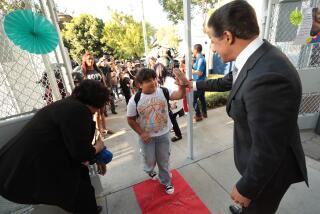Researchers Fail to Solve Bilingual Controversy
- Share via
SANTA ANA — Students who are not proficient in English make “substantially more rapid progress” toward fluency if they are taught in their native language or if they receive special assistance in English, according to a study of the public schools here made public Wednesday.
A much-anticipated study of language programs in Santa Ana Unified School District also found that, on average, achievement of full English fluency can take five to eight years--far longer than most studies have assumed.
But researchers from UC Riverside said their study yielded no definitive answer for policymakers, parents and voters who are wondering whether bilingual education or English immersion works best.
“So far, there’s not overwhelming or convincing evidence that one of these programs is flat-out superior to the other,” said Doug Mitchell, an education professor who led the study. “People . . . ought not to be in such an all-out hurry to take a side in this debate. This is a very complicated issue, and options are needed. You can’t ram everybody through one program and make it work for everybody.
“The best evidence here [shows] that students are different, and both programs are better than no program.”
The UC Riverside study is likely to be scrutinized closely because Santa Ana Unified has one of the largest bilingual programs in Orange County, and bilingual education has come under heavy criticism here in recent years.
Owing to a flood of immigration, more than 70 percent of the district’s 52,000 students are not fluent in English; most come from Spanish-speaking homes. A majority also qualify for federal poverty aid through lunch subsidies.
For its study, which began more than a year ago, UC Riverside reviewed data kept by the district in 1996-97 on what programs are taught to specific students and how they perform on standardized tests and other measures. Santa Ana’s records, researchers said, are unusually detailed for a large urban district.
Supt. Al Mijares referred questions Wednesday to an assistant superintendent, Alfonsina Quintana Davies. She said administrators have not yet decided what action should be taken in light of the study.
Nativo V. Lopez, president of the school board, said he could not comment on the study until he had read it. On Tuesday, before seeing the report, he had said he would support revising bilingual programs to move students more rapidly from Spanish instruction to English.
Santa Ana Unified officials are scheduled to review the study at a school board meeting Tuesday.
In the study, English immersion programs were defined as those in which students were taught almost exclusively in English but might have a bilingual teaching aide or receive specially designed visual and oral cues from the teacher to make the lesson comprehensible in English. About 7,100 students were in such classes.
Native language programs, known as transitional bilingual education, use primarily Spanish in the earliest grades but phase in English over time. Those classes accounted for 16,100 students.
The rest of the students received either a combination approach or no special help.
The study presented a dense, detailed profile of the learning patterns of students who are not fluent in English.
Such students, the study found:
* Tend to do better on mathematics tests conducted in Spanish, rather than English, until about the fifth grade.
* Tend to post faster gains in English in their earliest years, on average, but take longer to reach full fluency in later years.
* Tend to respond better to bilingual programs if they have scant English skills or advanced skills but to English immersion programs if they fall in between.
* Tend to do better in reading overall in the earliest grades when receiving native language instruction but are outperformed in grades four and five by students in English immersion programs or those who are given no special help.
Mitchell attributed that abrupt decline in reading performance to Santa Ana’s policy of moving students out of Spanish-based classes in third grade.
In fact, the study concluded that school officials ought to consider extending by at least two years the transition period from Spanish to English for students who are in bilingual programs. That might help to avert a “dramatic loss” in achievement that would unfairly demoralize the students, the report stated.
Mitchell said the study could not make a scientifically valid overall comparison of English immersion versus bilingual education because students were not assigned randomly to one program or the other.
More to Read
Sign up for Essential California
The most important California stories and recommendations in your inbox every morning.
You may occasionally receive promotional content from the Los Angeles Times.










